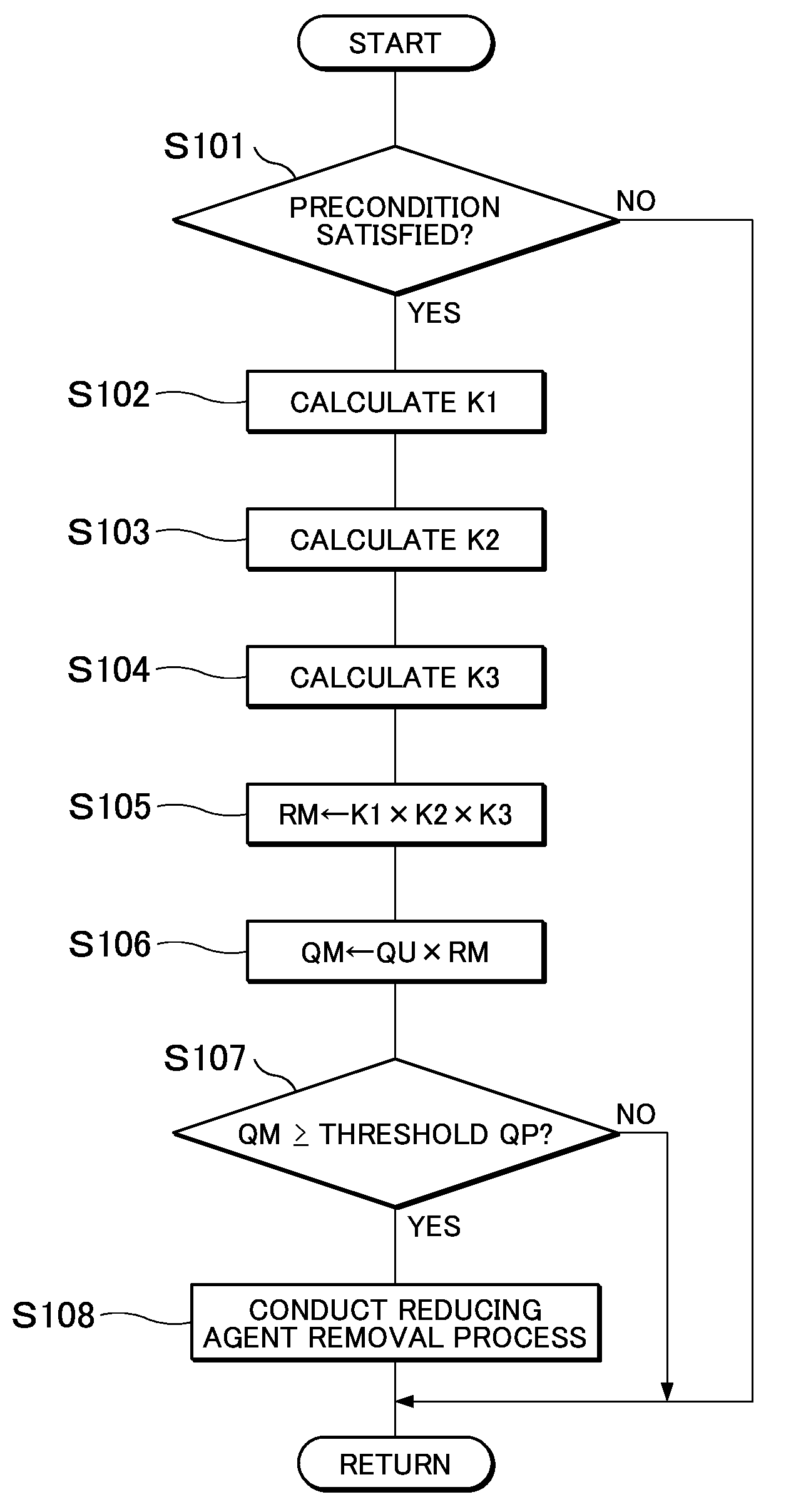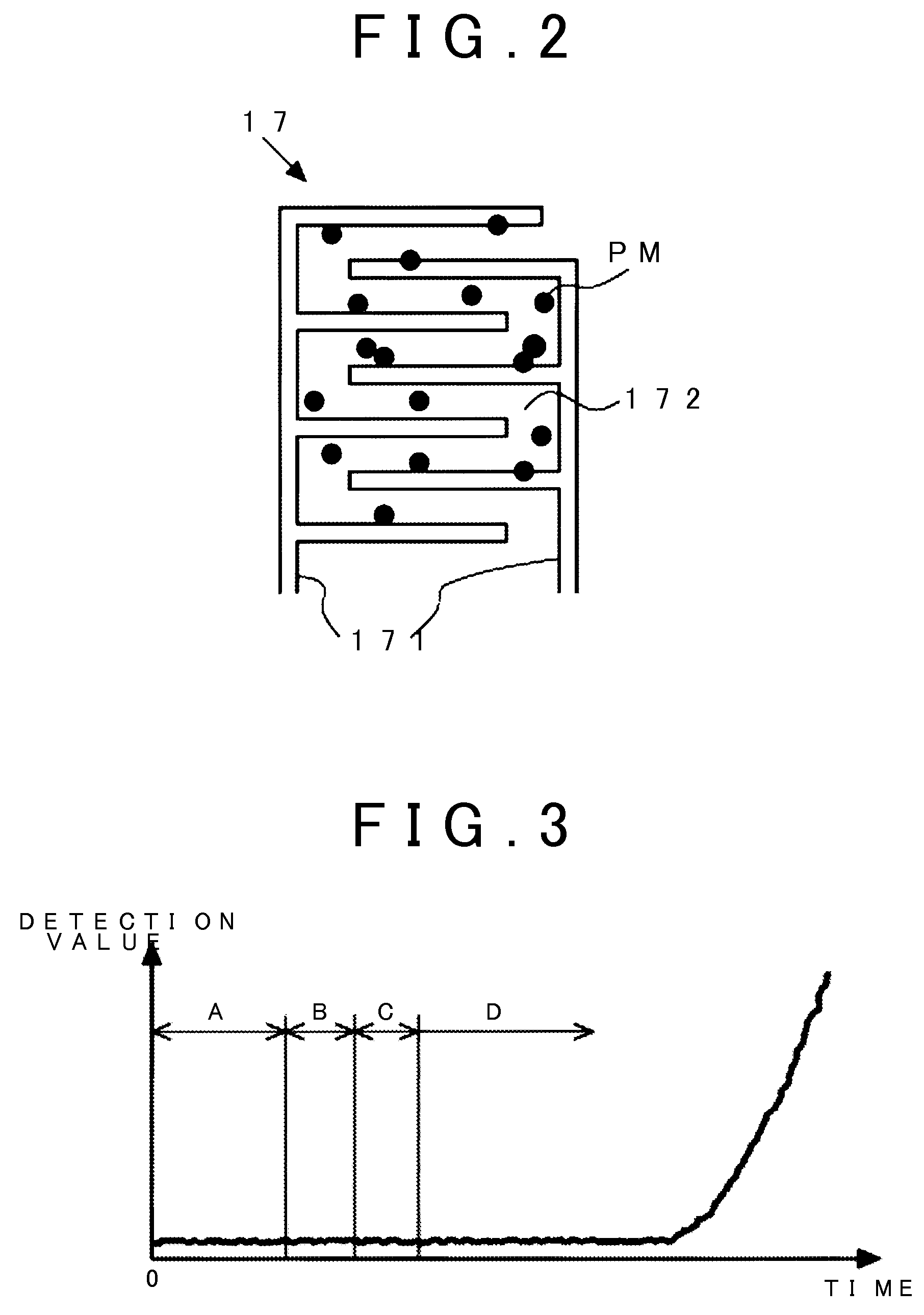Exhaust purification device for internal combustion engine
a purification device and exhaust technology, applied in the direction of machines/engines, mechanical equipment, separation processes, etc., can solve the problems of reducing becoming difficult to accurately detect the pm amount, etc., to reduce the determination of the filter trouble, the detection accuracy of the pm sensor can be restricted, and the effect of reducing the determination of the troubl
- Summary
- Abstract
- Description
- Claims
- Application Information
AI Technical Summary
Benefits of technology
Problems solved by technology
Method used
Image
Examples
first embodiment
[0052]FIG. 1 illustrates a schematic configuration of the exhaust purification device for an internal combustion engine in accordance with this embodiment. An internal combustion engine 1 shown in FIG. 1 is a diesel engine but may be a gasoline engine.
[0053]An intake passage 2 and an exhaust passage 3 are connected to the internal combustion engine 1. An air flow meter 11 that detects an amount of intake air flowing through the intake passage 2 is provided in the intake passage 2. Meanwhile, an oxidation catalyst 4, a filter 5, an injection valve 6, and a selective reduction type NOx catalyst 7 (referred to as NOx catalyst 7 hereinafter) are provided from an upstream side in a direction of exhaust flow.
[0054]The oxidation catalyst 4 may be a catalyst that has oxidation ability, for example, a three-way catalyst. The oxidation catalyst 4 may be carried on the filter 5.
[0055]The filter 5 collects PM in the exhaust. A catalyst may be carried on the filter 5. The filter 5 collects the P...
second embodiment
[0106]In the flow shown in FIG. 6, the reducing agent removal process is conducted when the estimation production amount QM is equal to or larger than the threshold. It can also be considered that the reducing agent removal process is conducted when the reducing agent amount that passes through the NOx catalyst 7 exceeds an allowable range. In contrast, in this embodiment, the reducing agent removal process is conducted in a case where the reducing agent passes through the NOx catalyst 7 independently from the amount of the reducing agent that passes through the NOx catalyst 7. For example, the reducing agent removal process is conducted in a case where at least one of the following conditions is satisfied that the flow rate or the flow speed of the exhaust that passes through the NOx catalyst 7 is equal to or higher than the threshold, that the temperature of the NOx catalyst or the temperature of the exhaust is equal to or lower than the threshold, and that the adsorption rate of ...
third embodiment
[0113]In this embodiment, a decrease in the detection value of the PM sensor 17 is added to conditions for conducting the reducing agent removal process other than the conditions described in the first and second embodiments. Other devices and the like are the same as the first embodiment, and the description will not be repeated.
[0114]Here, as shown in FIG. 5, if the PM sensor 17 is normal, the detection value increases along with the lapse of time or the detection value does not change unless the reducing agent removal process or a PM removal process is conducted. In other words, if the PM sensor 17 is normal, the detection value does not decrease along with the lapse of time. On the other hand, when the reducing agent attaches to the PM sensor 17, the detection value may decrease due to vaporization of the reducing agent.
[0115]Thus, a determination can be made that the reducing agent attaches to the PM sensor 17 in a case where the detection value of the PM sensor 17 decreases. F...
PUM
| Property | Measurement | Unit |
|---|---|---|
| temperature | aaaaa | aaaaa |
| temperature | aaaaa | aaaaa |
| temperature | aaaaa | aaaaa |
Abstract
Description
Claims
Application Information
 Login to View More
Login to View More - R&D
- Intellectual Property
- Life Sciences
- Materials
- Tech Scout
- Unparalleled Data Quality
- Higher Quality Content
- 60% Fewer Hallucinations
Browse by: Latest US Patents, China's latest patents, Technical Efficacy Thesaurus, Application Domain, Technology Topic, Popular Technical Reports.
© 2025 PatSnap. All rights reserved.Legal|Privacy policy|Modern Slavery Act Transparency Statement|Sitemap|About US| Contact US: help@patsnap.com



